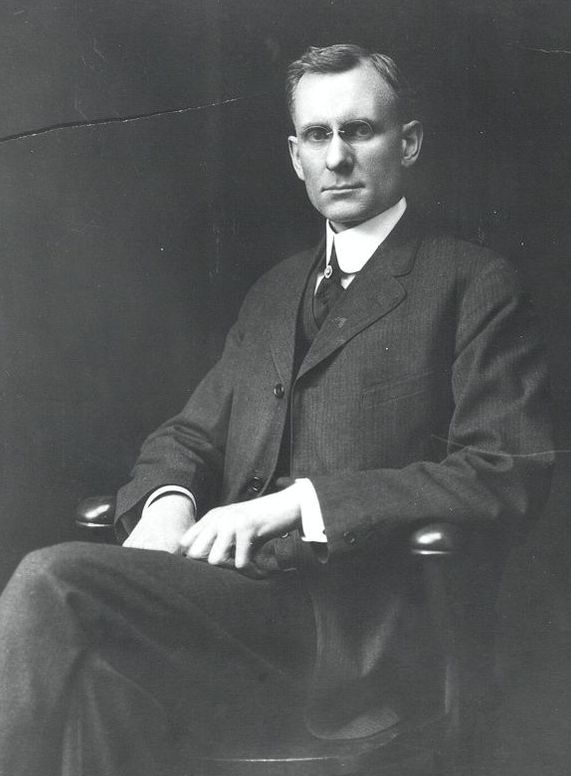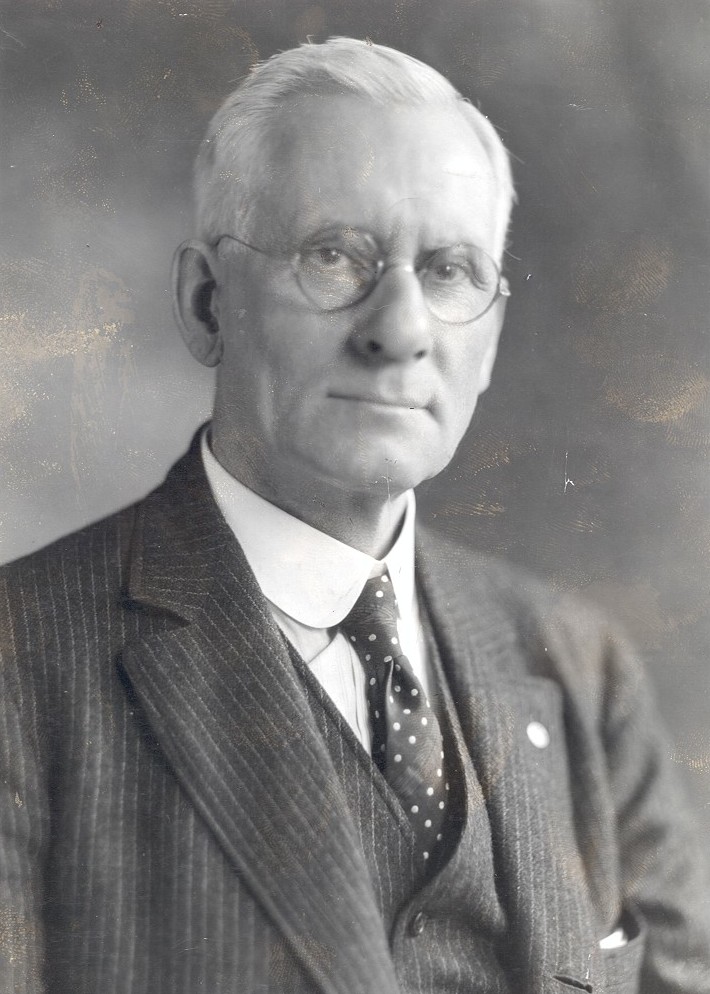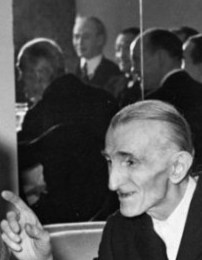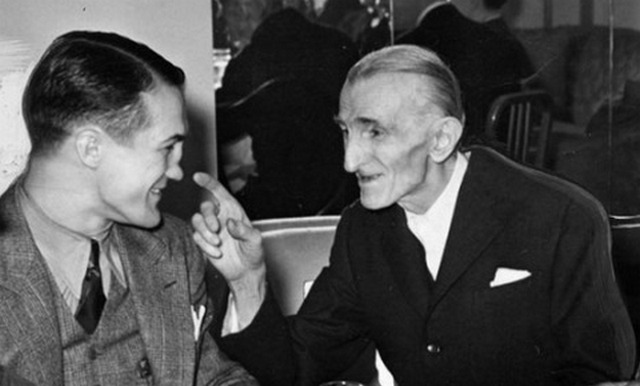Nikola Tesla's assistant Charles F. Scott

Spomenici Tehničkog fakulteta 1919-1929, Zagreb 1929.
Spomenica Tehničkog fakulteta 1919-1929, Zagreb 1929,
U tom zborniku su o Nikoli Tesli objavljena još četri
članka (autori su Miroslav Plohl, H. Görges,
F. Kiebitz i Milan Vidmar), a na str. 973 je objavljena i Teslina
fotografija preko cijele stranice formata A4.
The Contribution of Tesla to Electrical Power Development Charles F. Scott* *Mr. Scott entered the Westinghouse Company in the summer of 1888 and was assigned as assistant to Mr. Tesla in the early experimental work upon his motor. Mr. Scott continued with the Westinghouse Company for something over twenty years and participated actively in the development of the polyphase system and was intimately connected with the pioneer work at Niagara Falls. If one seeks the all important factor underlying the civilization of the nineteenth century in which the locomotive and the steamship made the world a compact unit and in which the industrial revolution enormously increased productive power and transformed our modes of life, he will find back of it all the steam engine. Steam power supplementing animal power was the motive power underlying the transformations in the civilization of the last century. And with the new century is coming a new acceleration or even a new industrial revolution. And again it is power, more power, a new kind of power, mobile, flexible, universal power - electric power, which is again transforming our civilization. To our present method of using electric power Nikola Tesla made an outstanding contribution. The induction motor which is in universal use and the polyphase system by which practically all electric power is now generated and transmitted were revealed in the United States patents granted to Tesla on May 1, 1888. To appreciate the significance of this invention it is essential to consider the state of the art at the time and also to tract its subsequent development. Prior to the introduction of the Tesla methods electric service was on a small scale. Arc lighting required a separate generator and circuit for each group of 50 or 100 lamps. Incandescent lighting was at first supplied by the direct current, three wire system which was so limited in its radius that many independent stations were required for lighting a large city. Electric railways required a different type of generating machinery. Motors were few in number operated sometimes from lighting circuits and sometimes from their own special generators and circuits. The introduction of the alternating current was a notable step in advance. The use of high voltage for transmission with transformers for reducing the voltage greatly extended the radius of economical distribution and led to a great increase in the use of electricity. But practically the whole use of the current was for incandescent lighting. There was no adequate motor. The alternating current which overcame the limitations of distance could not supply power. Tesla produced the induction motor adapted for use on alternating current and of marvelous simplicity in its construction and operation. His patents were immediately acquired by George Westinghouse, the outstanding advocate of alternating current. At first there was hope that the new motor could in some way be adapted for satisfactory operation on the existing single phase lighting circuits. But the motor called for polyphase circuits and for a lower frequency. Electric lighting companies hesitated about completely reequiping their generating stations to enable them to furnish auxiliary motor service and the motor, as a matter of fact, did not achieve its large distinction as a mere supplement to lighting service but in a new field of its own creation. In the early '90s the outstanding electrical development of the world was at Niagara Falls. In the development of an enterprise which contemplated the production of far more power than was produced at any single locality it was found essential that the power be produced by large water wheels of unprecedented size and then distributed over a considerable area. An international Niagara Commission of experts from various countries sought proposals on methods for the distribution of this power. The projects received advocated hydraulic transmission and transmission by compressed air and by electricity, some advocating direct current and one proposal, phase, alternating current. Lord Kelvin, Chairman of the Commission, and Edison, renowned inventor, strongly urged direct current. Westinghouse did not participate in the competition but later strongly recommended the polyphase alternating current which his company had been perfecting. The Niagara enterprise, after its world wide quest for an adequate power system chose polyphase alternating current, the Tesla system. The Niagara plant of 1895 inaugurated the great step in the transition from the mechanical power industry of the nineteenth century to the universal electric power of the present. A new method in power was inaugurated. Formerly power was produced locally at each factory by its own water wheel or engine. Now power sufficient for 100 mills or more was to be produced in a central station and distributed. It was to be transmitted and distributed electrically and to great distances. The electric generators of 5000 H. P. were several times larger than had ever been built. Furthermore, the new polyphase system enabled electric service of all kinds to be supplied from one source instead of requiring the multiplicity of small machines of different types as was then the common practice. These heterogeneous systems and circuits were replaced by one comprehensive system for universal service. This pioneer plan inaugurated at Niagara has been followed; the power systems of the world today and those planning for the future empoly the polyphase alternating current - the system proposed by Tesla in 1888. The induction motor, so beautiful in its basic principle and so simple in its mechanical construction, was at first regarded as Tesla's great achievement and the polyphase system was thought of as simply a means of supplying current to the motor. But in the development of electric power the polyphase system as a universal system for generating, transmitting, distributing and utilizing electricity in all forms has made possible the great power development of today. No other method is known for accomplishing what is now being accomplished by this method. But the real significance lies not in the invention itself nor in the marvelous growth of electric light and power service but in their industrial, economic and social significance. In the last few decades in the United States the horse power used in industry has increased several times as fast as the number of wage earners. Production has enormously increased as workers have used the power which the motor provides. Wages increase, working hours decrease and there is new opportunity for the development of the intellectual, the aesthetic and spiritual phases of life. Electricity in the factory, in the home and on the farm has produced significant changes in a few decades and in the coming centuries will have influences which are futile to predict. On May 18, 1917, exactly twenty-nine years after Tesla presented his first paper announcing his invention before the American Institute of Electrical Engineers, he was awarded the Edison Medal. The Electrical World editorially commented upon the event as follows: The
award of the Edison Medal to Nikola Tesla is most appropriate, in view
of the early contribution that he made to alternating-current motors.
In order to recognize that contribution, one must go back to the
period, thirty years ago, when alternating-current engineering was
greatly handicapped by the absence of motors capable of being installed
on alternating-current circuits.
It was at this point that Tesla invented the polyphase alternating-current system and polyphase motors, which, whether of the synchronous or of the asynchronous type, had the advantage of definite starting torque. It is generally understood that he was not the only inventor of the polyphase motor. The same idea seems to have occurred to one or two other independent inventors in Europe. But not only was Tesla the sole American independent inventor of the polyphase motor, but he was also the only inventor of it in the whole world who had faith in it. He believed in it enthusiastically and urged its claims both publicly and privately. He built the first small polyphase motor, which behaved very satisfactorily, and he urged the building of larger ones. Much experimenting, desiring and discarding had to be done before large polyphase motors could be built successfully, and the progress was slow; but Tesla's faith was unshakable and his claims were prophetic. A less enthusiastic mature might have quailed before the discouragements and have allowed success to escape. The polyphase motor was not Tesla's only pioneer contribution to electrical progress. He was a tireless experimenter, and his experiments carried him very early into the field of high-frequency alternators, or alternators which, in 1890, were considered to give high frequency. Later he developed the well known Tesla induction coil, or high-frequencey oscillator. With this new source he was able to demonstrate, during 1891 and 1892, in England, France and America, a number of entirely new electrical phenomena which at lower frequencies had been unobtainable. His lectures were given at the Royal Institution in London, the Franklin Institute in Philadelphia, and in various other places. The experimental phenomena he produced were dazzling and classical. They deservedly brought him great renown. The high-frequency phenomena that Tesla first developed and displayed had scientific rather than practical interest; but Tesla called attention to the fact that by taking his electric oscillator, grounding one side of it and connecting the other to an insulated body of large surface, it should be possible to transmit electrical oscillation to a great distance, and to communicate intelligence in this way to other oscillators in sympathetic resonance therewith. This was going far toward the invention of radio-telegraphy as we know it today. For the above reasons we welcome and acclaim the award to Nikola Tesla which the American Institute of Electrical Engineers has made of its Edison medal. We of this generation are prone to forget great efforts and the unwearying patience which have been necessary in the past to produce those results which are now the every-day electrical common-places of life, and it is well to signalize them, lest the next generation in its turn should forget the result of the pains and labor of this. |
- Charles F. Scott: Tesla’s Contribution to Electric Power [PDF],
- L. P. Wheeler: Tesla's Contribution to High Frequency [PDF].

Charles F. Scott, probably in 1920s. Source.
Charles F. Scott, past president AIEE (1902-03), was with Westinghouse Electric Company, 1888-1911; then professor of electrical engineering (now emeritus) at Yale University. He was assistant to Tesla, 1888-89. In Tesla's original type of motor with primary coils around individual poles he effected radical improvement by devising a slotte dsecondary with specially distributed winding. Motors of this type (about five horse power) successfully operated coal-mining machines as described in his paper in January 1891 before the Engineers Society of Western Pennsylvania, its first paper on mining. His AlEE paper describing two single-phase installations, for lighting at Portland, Oreg., and for power at Telluride, Colo. (for the latter he made the general plan) presented in June 1892 was the institute's first paper on long-distance transmission. He participated in planning and preparation of apparatus for the Chicago World's Fair and for the original hydroelectric development at Niagara Falls. His two-phase-three-phase transformer connection, more commonly known as the Scott T connection ("Polyphase Transmission, "National Electric Light Association, March 1894), was used in the transmission of three-phase current to Buffalo from the original two-phase generators. He was technical advisor to Edward Dean Adams in his preparation of the two volumes "Niagara Power" and has made a special study of the state of the art in the period when Niagara plans were crystallizing. He was chairman of section D, electric power transmission, of the International Electrical Congress, St. Louis, Mo., 1904. His recent interest in electrical developments just preceding and during his own contact with them in the 1890 period have given a perspective view which he presents in the present paper.
Charles Scott's concluding sentence of his 1943 article:The evolution of electric power from the discovery of Faraday in 1831 to the initial great installation of the Tesla polyphase system in 1896 is "undoubtedly the most tremendous event in all engineering history." (Here, Scott cites Edwin H. Armstrong, Edison Medalist 1942.)
Albert Einstein (Nobel Prize in Physics 1921) "It is with great joy that I hear you are celebrating your 75th birthday, and as a successful pioneer in the field of high frequency energy you have experienced the miraculous development of this area of technology. Congratulations on the great success of your life’s work." (from Einstein's birthday greeting to Tesla sent in 1931, written in German)
Robert A. Millikan (Nobel Prize in Physics 1923) "When I was a student in Columbia University I attended a downtown public lecture in New York at which you made one of the first demonstrations of your Tesla coil and its capabilities. Since then I have done no small fraction of my research work with the aid of the principles I learned that night."
Arthur H. Compton: (Nobel Prize in Physics 1927) "To men like yourself, who have learned first hand the secrets of nature and who have shown us how her laws may be applied in solving our every-day problems, we of the younger generation owe a debt that cannot be paid.
Lee De Forest: (American inventor) "No one so excited my youthful imagination, stimulated my inventive ambition, or served as an outstanding example of brilliant achievement in the field I was eager to enter, as did yourself. Your simple statement that you knew I could succeed, renewed my courage and gave me new faith in myself at a time when I was sorely tried."
The last three citations are from the Memorandum Book on the Occasion of Tesla's 80th Birthday, Edition de la Société pour la Fondation de l'lnstitut Nikola Tesla. Belgrade, 1936.

Charles F. Scott, probably in 1930s. Source.

Nikola Tesla je 1892. postao jedan od triju dopredsjednika AIEE (American Institute of Electrical Engineers; od 1963. IEEE). Podatak zahvaljujem g. Mariu Filipiju iz Zagreba.
U razdoblju od 1902.–1903. g., Charles F. Scott je bio na istaknutom položaju predsjednika Američkog instituta elektroinženjera (AIEE; od 1963. IEEE). Njegova je važna uloga bila u boljem povezivanja raznih elektrotehničkih društava u SAD-u, kao i u sistematskom radu s mlađim naraštajima. Radi toga je potaknuo vrlo poznatog škotsko-američkog industrijalca i dobrotvora Andrew Carnegie-a, da financira izgradnju nebodera AIEE-a od trinaest katova u New Yorku.
CHARLES F. SCOTT
YALE STATION
NEW HAVEN, CONNECTICUT
Birthday Greetings to Nikola Tesla
I well remember an evening about the middle of August, 1888, in the Westinghouse testing room at Pittsburgh. I had just come with the Company and was assistant to Ed Spooner who was running the dynamo testing room at night. He called me and said "There comes Tesla."
I had heard of Tesla. A few months previous I had read his paper on the polyphase induction motor which my former college professor had pronounced as a complete solution of the motor problem. And now I was to see Tesla himself.
There he came, marching down the aisle with head and shoulders erect and with a twinkle in his eye. It was a great moment for me.
And later on I became Tesla's wireman and his assistant in preparing and making tests. It was a splendid opportunity for a beginner, this coming in contact with a man of such eminence, rich in ideas, kindly and frinedly in disposition.
Tesla's fertile imagination often constructed air castles which seemed prodigious. But I doubt whether even his extravagant expectations for the toy motor of those days measured up to the actual realization. For the polyphase system which it inaugurated is the basis of the electric transmission and power service of today, exceeding in magnitude and usefulness and promise for the future the wildest dreams of the early days.
And so from the standpoint of useful achievement for the benefit of mankind and in memory of most pleasant and personal relations, I extend heartiest greetings on this his severnty-fifth anniversary.
Charles F. Scott (signature)
July 3, 1931
Source of Scott's letter: To Nikola Tesla Greeting his Seventy-fifth Anniversary, July 10, 1931, Museum of Nikola Tesla, Beograd, 2006

Birthday greetings to Nikola Tesla by Charles F. Scott in 1931.
Nikola Tesla's Assistant Charles Scott Talks About Work in the 1880s: Restored Video and Audio




Nikola Tesla in good spirits with three of the Zivic brothers: Eddie, Pete and Fritzie. Source.
Zahvale. Zahvaljujem doc. dr. Petru Javoru (u miru, Zavod za primijenjenu matematiku FER-a) na darovanom primjerku Spomenice Tehničkog fakulteta 1919-1929,
Zagreb 1929. Također zahvaljujem prof. dr. Zvonku Benčiću (sa Zavoda za
učinsku elektroniku FER-a) na poticajima u istraživanju nepoznatih ili
slabo poznatih pojedinosti iz života Nikole Tesle.
Literatura
- Schooling of Nikole Tesle in Croatia and his teacher Martin Sekulić
- Nikola Tesla: My Inventions (na lijevoj stranici, lijevo od fotografije indukcijskog motora, nalazi se opis njegova genijalnog profesora iz Karlovca, Martina Sekulića)
- Tehnički fakultet Sveučilišta / kraljevine Jugoslavije u Zagrebu, 1919-1929, Spomenica fakultetskog savjeta, Preštampano iz godišnjaka Sveučilišta u Zagrebu 1924/1925 - 1928/29, Zagreb 1929, Tisak nadbiskupijske tiskare.
- Darko Žubrinić: Duhovnost Nikole Tesle